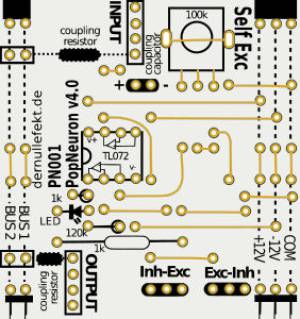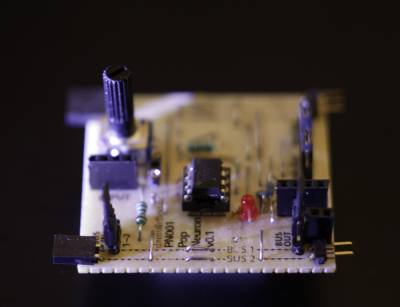This is an old revision of the document!
Table of Contents
Pop Neuron - An Analog Artificial Neural Network
The Analog Computer Confetti is a modular system that makes it possible to perform all kind of computations and operations on base of electrical voltage.
Pop Neurons are special modules to implement an analog artificial neural network
into the multi-connect system of the Confetti. Both systems have been and still are designed by Wolfgang Spahn, the Confetti system since 2015 and the Pop Neurons since 2017/18.
The Analog Computer Confetti was used in combination with nearly 100 Pop Neurons for the installation Symbolic Grounding by Christian Faubel and Wolfgang Spahn. Also, the analog computer was key for the installation Strange Attractors by Wolfgang Spahn.
The analog computer Confetti was first presented at the residency at Art Science BLR and the Indian Sonic Research Organization at a Srishti Institute of Art, Design and Technology, courtesy of Goethe-Institut Max Mueller Bhavan in 2016.
The development of the Pop Neurons was supported by Künstlerdorf Schöppingen in 2017, where Christian Faubel and Wolfgang Spahn conducted preliminary work.
Explaining the Circuit
The bicore oscillator used by the BEAM (Biology, Electronics, Aesthetics, Mechanics) robotic group for their BEAMbots is the origin of the Pop Neuron. The Pop Neuron is one half of this circuit with the option to change the resistor-capacitor components. The bicore oscillator is a classic Schmitt-Trigger oscillator, with all components used twice.
The Pop Neuron are constructed with some slight differences. For example to avoid “digital” CMOS chips in the analog computer Confetti the Schmitt-Trigger (respectively the inverting Schmitt-Trigger) is build out of OpAmps similar like the Confetti Schmitt-Trigger and the Confetti Inverting Schmitt-Trigger boards. The option to add an Resistor-Capacitor-Circuit in the sockets on the board - like in many other designs of Confetti modules - makes the Pop Neuron more flexible to use in different frequency ranges.
Thus one can use the Schmitt-Trigger in combination with the plug-in slots of the Pop Neuron module to create an analog neuron. In adding resistors and capacitors to it one can build an excitatory or an inhibitory neuron out of a Pop Neuron 001 module, depending on the jumper setting.
The Pop Neuron 002 and 003 can be used in the similar way, but they have a prefixed behavior setting, i.e. they are always excitatory or inhibitory.
With two different neurons one can build an oscillator, with more neurons one can build a whole analog artificial network.
Acknowledge
These oscillator and network behave similar to the one described in Dynamics of Pattern Formation in Lateral-Inhibition Type Neural Fields by Shun-Ichi Amari. The implementation of the analog neuron was described in Implementation of Artificial Neural Oscillators in 2009 by Pavlo V. Tymoshchuk, Yuriy I. Paterega.
A digital implementation on syncing and desyncing processes of two mutually coupled systems one can find on Netze/Networks Neural Oscillators by Lab3 - Laboratory for Experimental Computer Science at the Academy of Media Arts Cologne.
An other example of an electric implementation of an analog neuron for controlling robots one can find in Neurodynamische Module zur
Bewegungssteuerung autonomer
mobiler Roboter by Manfred Hild.
Neural Sound Synthesis
One can use these neurons to generate pattern and structures for all kind of sequencers and also for synthesize sound for musical instruments similar like the one David Tutor used for his Neural Synthesis Nos. 6-9 in 1993. A description of his work by Forrest Warthman and Mimi Johnson is on the artist web-side: The Neural Network Synthesizer. His neural synthesizer were based on the 80170NX Electrically Trainable Analog Neural Network chip by Intel.
Wolfgang Spahn build for the installation Symbolic Grounding by Christian Faubel and Wolfgang Spahn a synthesizer out of Confetti and Pop Neuron modules.

The Confetti Neuron
Because the Pop Neurons have some fundamental problems when it comes to use in audible realm Wolfgang Spahn designed a complete new board in 2019, the Confetti Neuron.
Some of the problems were for example the much to high power consumption of the Pop Neurons. That leads regularly in hear able voltage fluctuations every time some other neurons - beside the ones one wants to listen - started to fire. An other problem were the big capacitors one had to use in the RC-circuit. To get some nice low frequency oscillation one needed sometimes 2000µF capacitors or higher. And an other serious downside of the Pop Neurons were the ugly shaped capacitor charging curve - that's a bad precondition for nice sound synthesis.
And also the theoretical model of the Sun-Ichi-Amari neuron demands for an internal feedback and that is missing in the Pop Neuron.
These problems are solved with the design of the Confetti Neuron and the new board also comes with some more benefits like an extra output for the nice triangle wave that one can use for audio signals and the need of just one jumper to set the behavior from excitatory to inhibitory.
All other Pop Neuron boards also have a newer and better equivalent in the Analog Computer Confetti.
So all Pop Neuron boards are obsolete!
Patching
For connecting the Pop Neurons one can use the bus on all boards or just use patching wires. Certainly, a combination of both is possible.
For a neural oscillator the output of the neuron has to be connected to the input of the other, and vice versa.
Modules
All Pop Neuron boards and modules are obsolete!
Please use the Neural Network Modules of the Analog Computer Confetti

The PCB version of the PN001 Pop Neuron the Pop Neuron Shenzhen Ready on kitspace.org.
Made by Marc Dusseiller and the SGMK.


